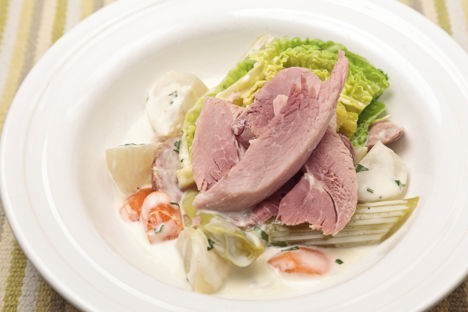Gammon is a real treat, often bringing back memories of enormous, steaming-hot cuts brought out at Christmas. With enough meat to feed a hoard of hungry pork-lovers, it’s a great choice for a big party. Much confusion exists about the difference between gammon and ham - both of these meats come from the rear leg area of the pig and both are cured (either in a wet brine or a dry salt rub). However, gammon is sold raw and must be cooked before you consume it, while ham will be edible upon purchase due to being completely dry-cured, wet-cured or cured, smoked and aged.
What to look for when buying gammon
The quality of pork available varies a great deal; depending on where you buy it from and what environment the pig was raised in. Intensive farming methods are widespread in some parts of the world, where animal welfare levels have been criticised by animal rights organisations. For this reason, buy pork products that hold a certified quality assurance stamp, such as Red Tractor, Freedom Foods or Soil Association. Do not settle for gammon labelled ‘processed in the UK’ as this can still mean that the pig has been raised and slaughtered in another country, before being shipped over and cured.
The array of gammon available is vast once you start looking. Once you’ve settled on buying good quality pork (rare breeds such as Tamworth and Gloucester Old Spot are raised on a small-scale and make very good eating), there is the curing and smoking to consider. Gammon is sold wet-cured or dry-cured, smoked or unsmoked (green). Both the curing process and the smoking process add various flavourings to the meat - cures can contain ingredients ranging from cider to mustard, while different varieties of wood chip such as oak or cherry can be used to infuse smoky flavouring into the gammon. Consult with your butcher about what kind of gammon to use for your desired dish.
How to cook gammon
Depending on the varying curing methods and levels of salt used, gammon may have to be soaked or boiled before cooking, so consult your butcher (or check the labelling) before you start. You can test the saltiness of the gammon by cutting off a small chunk of the meat and frying until cooked through in a little oil - taste the meat, it should be pleasantly salty but not overwhelmingly so. How you cook gammon should depend on the cut of gammon you are using - a leg joint, which can have the bone in or be de-boned, a rolled joint of gammon, a gammon steak or gammon rashers are all available.
Probably the most commonly used cooking method for gammon is roasting. Roasting a large gammon joint is great for feeding the family and is pleasingly economical. And you can use leftover roast gammon in many dishes, from pasta bakes to homemade baked beans. Braising is another popular cooking method, and is particularly apt for both large gammon joints and leg steaks.
Once gammon is cooked, it can be used in a wide variety of dishes, from elegant terrines such as Galton Blackiston’s to midweek meals like Shaun Hill’s gammon, leek and mustard pasta bake.
Gammon doesn’t need to be cooked all day before it can be eaten - gammon steaks and rashers are better suited for a midweek supper. Steaks can be grilled or pan-fried, usually ready to eat within ten minutes, while rashers can be treated similarly to bacon.
What gammon goes with
Gammon stands up well to warming spices – as exemplified by Graham Campbell’s roast gammon dish, which uses a mix of five-spice, soy, cinnamon and cardamom to make a heady glaze for the meat. Blogger Victoria Glass also recommends piquant flavours, using a jerk marinade (Scotch bonnet chillies, allspice, rum, ginger and muscovado sugar) to flavour the gammon before it cooks.
Apple is the famous partner to gammon. And James Mackenzie adds a boozy twist to this delicious combo - braising gammon in Scrumpy cider before coating in a sticky honey and mustard glaze and roasting.
Sweet, spicy, tart, sour - gammon can work with the full gamut of flavours, so be adventurous. James Mackenzie serves gammon with an inspired gooseberry ketchup, Emily Watkins pairs with the fresher notes ofpea and mint and Josh Eggleton studs a gammon with cloves and serves with parsley sauce. If you want to keep things simple, serve with a watercress, pea shoot and radish salad.
Get in touch
Please sign in or register to send a comment to Great British Chefs.



